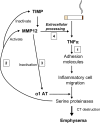Biomarkers in chronic obstructive pulmonary disease: confusing or useful?
- PMID: 24532968
- PMCID: PMC3923613
- DOI: 10.2147/COPD.S42362
Biomarkers in chronic obstructive pulmonary disease: confusing or useful?
Abstract
The field of biomarker research has almost reached unmanageable proportions in chronic obstructive pulmonary disease (COPD). The developments of new technology platforms have generated a huge information data base, both cross sectionally and increasingly, longitudinally. The knowledge emerging provides an enormous potential for understanding the disease pathophysiology, for developing markers specific for long-term outcomes, and for developing new therapeutic strategies. However, the excitement must be tempered with an understanding of the limitations of the data collection techniques, and of the variations in disease state, activity, impact, and progression. Nevertheless, the most crucial aspect in interpreting the current literature is the recognition of the relatively superficial characterization of what is a complex group of pathological processes with a common end point of airflow limitation. The current review explores some of these issues together with those areas where real progress appears to have been made, and provides caution on interpretation.
Keywords: emphysema; inflammation; secretions; technology platforms.
Figures





Similar articles
-
Chronic obstructive pulmonary disease with mild airflow limitation: current knowledge and proposal for future research - a consensus document from six scientific societies.Int J Chron Obstruct Pulmon Dis. 2017 Aug 29;12:2593-2610. doi: 10.2147/COPD.S132236. eCollection 2017. Int J Chron Obstruct Pulmon Dis. 2017. PMID: 28919728 Free PMC article. Review.
-
The role of desmosines as biomarkers for chronic obstructive pulmonary disease.Expert Rev Respir Med. 2013 Apr;7(2):137-44. doi: 10.1586/ers.13.4. Expert Rev Respir Med. 2013. PMID: 23547990 Review.
-
Comparative Study of Cytokine Levels in Different Respiratory Samples in Mild-to-Moderate AECOPD Patients.Lung. 2019 Oct;197(5):565-572. doi: 10.1007/s00408-019-00263-y. Epub 2019 Aug 26. Lung. 2019. PMID: 31451927
-
Novel aspects of pathogenesis and regeneration mechanisms in COPD.Int J Chron Obstruct Pulmon Dis. 2015 Jun 2;10:995-1013. doi: 10.2147/COPD.S82518. eCollection 2015. Int J Chron Obstruct Pulmon Dis. 2015. PMID: 26082624 Free PMC article. Review.
-
Systemic Markers of Adaptive and Innate Immunity Are Associated with Chronic Obstructive Pulmonary Disease Severity and Spirometric Disease Progression.Am J Respir Cell Mol Biol. 2018 Apr;58(4):500-509. doi: 10.1165/rcmb.2017-0373OC. Am J Respir Cell Mol Biol. 2018. PMID: 29206476 Free PMC article.
Cited by
-
Animal Models Reflecting Chronic Obstructive Pulmonary Disease and Related Respiratory Disorders: Translating Pre-Clinical Data into Clinical Relevance.J Innate Immun. 2020;12(3):203-225. doi: 10.1159/000502489. Epub 2019 Sep 17. J Innate Immun. 2020. PMID: 31527372 Free PMC article. Review.
-
Contribution of small airway inflammation to the development of COPD.BMC Pulm Med. 2024 Mar 5;24(1):116. doi: 10.1186/s12890-024-02911-3. BMC Pulm Med. 2024. PMID: 38443860 Free PMC article.
-
Utility of an artificial intelligence-based lung CT airway model in the quantitative evaluation of large and small airway lesions in patients with chronic obstructive pulmonary disease.BMC Pulm Med. 2025 Aug 1;25(1):371. doi: 10.1186/s12890-025-03848-x. BMC Pulm Med. 2025. PMID: 40751241 Free PMC article.
-
Serum Metabolite Biomarkers Discriminate Healthy Smokers from COPD Smokers.PLoS One. 2015 Dec 16;10(12):e0143937. doi: 10.1371/journal.pone.0143937. eCollection 2015. PLoS One. 2015. PMID: 26674646 Free PMC article.
-
Biomarkers of progression of chronic obstructive pulmonary disease (COPD).J Thorac Dis. 2014 Nov;6(11):1532-47. doi: 10.3978/j.issn.2072-1439.2014.11.33. J Thorac Dis. 2014. PMID: 25478195 Free PMC article. Review.
References
-
- Cote CG. Surrogates of mortality in chronic obstructive pulmonary disease. Am J Med. 2006;119(10 Suppl 1):S54–S62. - PubMed
-
- Clark KD, Wardrobe-Wong N, Elliott JJ, Gill PT, Tait NP, Snashall PD. Patterns of lung disease in a “normal” smoking population: are emphysema and airflow obstruction found together? Chest. 2001;120(3):743–747. - PubMed
-
- Jones PW. Health status and the spiral of decline. COPD. 2009;6(1):59–63. - PubMed
Publication types
MeSH terms
Substances
LinkOut - more resources
Full Text Sources
Other Literature Sources
Medical

